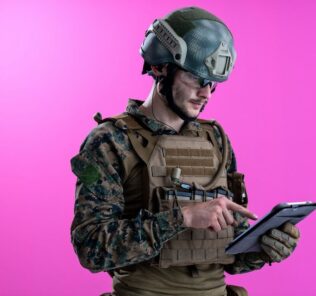SimGHOSTS 2021 Keynote Address Medical XR Data Protection Framework
Presented by XR Safety Initiative (XRSI) founder and CEO, Kavya Pearlman, the 2021 SimGHOSTS keynote address was titled “Medical XR in the Era of Constant Reality Capture.” During her discussion, Pearlman explained that medical XR and spatial computing can help transform unsustainable healthcare systems into sustainable ones by providing cheaper, safer and faster active solution technologies. She also announced the commencement of “The Medical XR Privacy and Safety Framework,” which is intended for launch on August 10 to establish a baseline across XR.
The 2021 SimGHOSTS event was held from August 3 to 6, 2021 both virtually and in-person in Fort Wayne, Indiana at the Parkview Mirro Center for Research and Innovation. Across both versions (online vs in-person), participants were able to explore new products, technologies and techniques from leading industry partners. In addition to Pearlman’s presentation, some other sessions included:
- Manikin Connectivity: Simulation Networking Solutions Panel: Presented by Nick Brauer, Ferooz Sekandarpoor, Adam Fischer, methods of connecting simulation technologies and work-arounds were shared.
- Simulation Specific Systems: Considerations for use, creation and implementation: Presented by Donovan Rojas, this session included an overview of learning management systems, audio-visual, scheduling, and inventory systems. Additionally, this session reviewed opportunities from an IT perspective to maintain security, and take advantage of existing infrastructure/security resources made available at many large institutions.
- Engaging Students as Simulation Gamemasters: Presented by Anthony Reynolds, Angela George, Kelley Connor, PhD, RN, CHASE, this discussion explained the process of facilitating technology logistics, the Gamemaster role, and the simulation methodology.
- Think Apollo 13: Innovation and Invention in the Face of Covid-19: Presented by Dr. Alton Liu, Charlotte Gabet, Adam Fischer, this session team from the Mirro Center for Research and Innovation reflected on how they approached many of the needs within the healthcare community, those near to home, across the nation and globally.Using the Standards of Best Practice: What’s easy? What’s hard?: Presented by Suzan Kardong-Edgren, this session allowed participants to share their pearls and pitfalls when using the Standards. Hospital and academic groups shared with each other how they have made the Standards work for them in their unique environments.
Previously, the not-for-profit organization that promotes privacy, security, and ethics in immersive environments (virtual reality, mixed reality, and augmented reality), XRSI, developed a privacy and safety framework for the XR and spatial computing domain. This was a baseline overview, outlining problems and risks that can be encountered. Using this foundation, the company is expanding upon this framework to focus on the combination of the medical domain and immersive technologies. XRSI plans to invite key stakeholders to participate in meetings to help assess processes and understand medical aspects.
Sponsored Content:
“This framework is something that we would potentially use to establish trust because we absolutely need to do that. By benchmarking functionalities and evaluating functionalities seamlessly XRSI can help create trust,” Pearlman said. “The most valuable thing here is the data, so we focus on patient data or patient safety when we talk about this framework.”
Developing this type of framework has become essential due to the “ocean of data we’re swimming in.” With so much data available, privacy and autonomy have become primary concerns. According to Pearlman, additional protocols may be needed to protect the data of both patients and providers, as well as new rules for patients’ information exchange, transparency and accountability around the information collected. When dealing with sensitive information available to XR hardware, informed consent in the Medical XR domain is critical.
“Imagine if we were talking about somehow either replicating consciousness or over time connecting to human brains. We are progressively getting there slowly,” Pearlman said. “Before we get there, we need to understand that this is not going to be a national security term, for example, for certain countries.”
In the meantime, medical XR is being used to collect medical data to infer any number of conditions a person may have to deliver real-time, customized treatment. Clinicians can use XR to engage with patients better to free up their time. XR technology data collection now also includes biometrically inferred data, which is especially prevalent in XR data pipelines and is inferred from a behavior, a physical or psychological biometric identification technique. The data could be non-verbal, or any communication method such as facial recognition, iris scanning or retinal analysis.
Sponsored Content:
“When we build these verticals, we keep in mind that that data that they’re using to authenticate, diagnose or to research must be contained, segmented, and properly protected,” Pearlman explained.
Yet, without FDA oversight, the fear is that patient data will be mined and sold to insurance providers. They could then potentially deny coverage based on a condition the patient is not yet aware of.
“The purpose of any XR based medical system must be promoting patient health and keeping them safe, right? It must never, ever, ever should be selling ads,” Pearlman stressed. “How horrible would it be if you trust your doctor or your healthcare system and they potentially just take your data or while you’re consuming some of these technologies?”
Further, Pearlman emphasized that patient data belongs to the patient and their health and safety should be the primary focus of this data collection. If used for healthcare and research alone, medical XR’s benefits become clear. She said that, in the name of research, professionals should break down the silos on patient data collection and sharing because this could ultimately save someone’s life.
“This may help potentially an algorithm or a human diagnose a person better, so it is good to collect data, but with purpose, with a specific context and not new excessive data collection. We need to protect patient data, but this could be exploited benevolently or intentionally. We’ve heard of several data breaches over the years, and I started my cybersecurity career in 2011.”
Moving into the future, Pearlman noted that to evaluate technologies against protocols, the FDA could be incorporated to enforce noncompliance. She said that to date, one federal agency has already expressed interest in funding the additional framework. Once established, professionals could display a framework certification on their website, or directly on devices. Then, they could connect with global regulatory bodies to explain how the framework was established, how the framework should be used and tap on support from the NHS.
“We focus on privacy and security aspects of patient data and ensure that the patient is informed to be qualified, to consent to how it is used and how we ensure data that is collected and transmitted for patient health efficacy and exclusion,” Pearlman said. “We need your help to make our future truly private before billionaires say future is private future. Doesn’t just become private. We have to build protocols and we have to define standards.”
More About SimGHOSTS
SimGHOSTS, also known as The Gathering Of Healthcare Simulation Technology Specialists, is an international United States-based non-profit organization. The organization is dedicated to supporting individuals and institutions operating medical simulation technology and spaces through hands-on training events, online resources and professional development.
By offering support and resources to medical simulation professionals, SimGHOSTS hopes to create a healthcare education culture where people are empowered to use simulation technology to improve learning and patient care outcomes. For this reason, SimGHOSTS has created six core values, the first of which is to innovate the world of healthcare simulation and patient safety.
Other organizational core values include advocating for those operating healthcare simulation technology spaces, educating the professional community to improve outcomes and networking with global community members at regional events and online hubs. The last two core values are to engage champions, institutions and organizations, and zeal for the craft of simulation in healthcare throughout the community and profession.
Learn More About SimGHOSTS
Lance Baily, BA, EMT-B, is the Founder & CEO of HealthySimulation.com, which he started while serving as the Director of the Nevada System of Higher Education’s Clinical Simulation Center of Las Vegas back in 2010. Lance is also the Founder and acting Advisor to the Board of SimGHOSTS.org, the world’s only non-profit organization dedicated to supporting professionals operating healthcare simulation technologies. His co-edited Book: “Comprehensive Healthcare Simulation: Operations, Technology, and Innovative Practice” is cited as a key source for professional certification in the industry. Lance’s background also includes serving as a Simulation Technology Specialist for the LA Community College District, EMS fire fighting, Hollywood movie production, rescue diving, and global travel. He and his wife Abigail Baily, PhD live in Las Vegas, Nevada with their two amazing daughters.
Sponsored Content:



















